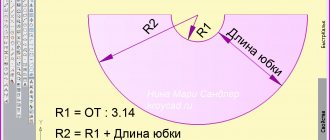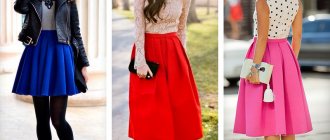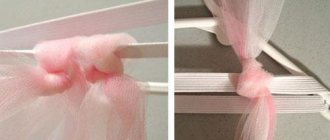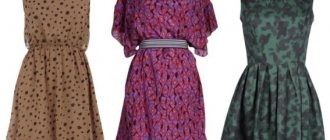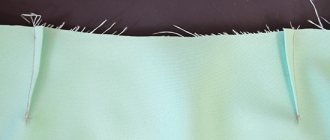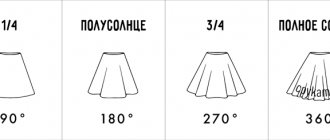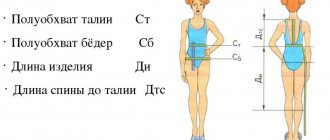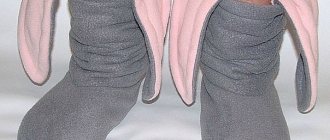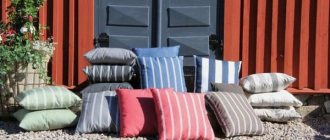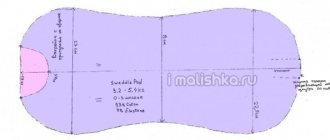I welcome you, friends, to my resource. Today the topic of my article is “How to sew a sun skirt: step-by-step instructions with photos,” where I will tell and show you everything. And you can easily make yourself such a flared sun skirt using my step-by-step instructions with your own hands and will wear it with pleasure. And, if you need to, sew a flared skirt in two or even three suns.
For the first experiment, you should take cotton fabric without a pattern. Then you won’t have to struggle with stretching the fabric, adjusting the pattern and other nuances. Today we are just learning how to cut a circle skirt.
First, let's look at this question - how to correctly lay out the skirt pattern on the fabric. If we are sewing a skirt about 60 cm long and the width of our fabric is 140 cm or more, then the patterns should be laid out along the longitudinal line. If the length of the skirt is more than 60 cm, then it can be laid out as in Figures 1 and 2, depending on the width of the fabric.
It is possible (if the skirt is small) when a full circle is cut out at once. And the skirt comes out completely without seams. Then the pattern needs to be laid out differently.
Determining the size
It is necessary to take measurements with a measuring tape along the waist line. It is she who will help clarify its circumference. We need to know the length - r and the length - R. Knowing these dimensions, we can draw a circle for the sun skirt. R is a segment of the length of the skirt (add 1.5 cm to it for the hem of the bottom), r - we will calculate as shown below.
The waist circumference was 79 cm, but we need to find out the radius of this circle. Therefore, we use this formula: r = waist circumference, divide by 2 Pi. r = 79/6.28 = 12.5 cm. The resulting radius can be rounded up or down.
Varieties of styles
It is very easy to create a pattern; it is enough to draw two circles, one of which will be the lower part of the product, and the other will serve as the basis for sewing the belt. The resulting folds can be stitched to the middle of the thigh, then you will get a completely new model. Sometimes a skirt is cut with a difference in length, this is stylish and extraordinary. You can radically change the style by adding a yoke, but only an experienced seamstress can handle this task.
If you don't want the hem to be too wide, create a half or quarter sun pattern. The skirt will be flared, but the number of tails will be reduced. Such models do not require much fabric, but they look elegant. To determine which style is right for you, measure your waist and hips. If the difference between them is more than 20 cm, then the length of the product should be below the knees, with the maximum number of folds. The color of the fabric should be monochromatic and rich.
Children's matinees are a long-awaited holiday where every girl dreams of looking like a princess or fairy. A circle skirt made of tulle or organza is the best option. Cutting and sewing will not take much time. And then everything depends on your imagination. The decor can be varied: beads, rhinestones, sew-on sequins, appliqués. Your little one will be the center of attention at any event! We will tell you later how to determine fabric consumption.
Constructing a pattern
First we mark the landing radius r. Then we mark the length of the skirt R + 1.5 cm (an increase for the bottom of the skirt for hemming). Another 0.5 cm is added to the upper cut.
After calculating r = 12.5 cm from the upper corner of the square, we measure this distance with a centimeter tape and use a pencil to put the first mark, and the other mark 54.5 cm from the upper corner, since the skirt has a length of 40 + 1.5 + 0, 5 + r = 54.5 cm.
When both radii have been marked, you need to draw two circles on paper. We take a measuring tape and from the corner of the upper square, following the marks, draw a smooth line with a pencil of length r and R.
Cut out the top and bottom skirt
On the cutting table, unfolded, we lay out the fabric, the width of which is 1 meter 50 centimeters. We place the pattern up along the longitudinal line, retreating 1.5 cm from the top cut (this is necessary so that there are seam allowances left on the side cuts of the skirt), as shown in the figure. We cut out the first part of the main skirt, then make the second half in the same way. We continue to cut out the skirt - double sun.
We cut out the second skirt, which is located under the main one. We lay out the lining material on a flat surface 1 m 50 cm wide. We place a paper pattern on it, departing 1.5 cm from the top. We add 8 cm to the bottom of the lining skirt. We cut out the first part of the product, then cut out the second half using the same technology.
Lastly, the belt is cut out. This detail is cut for a skirt - a double sun along the lobar or transverse. It can be stitched or one-piece. Waist circumference 79 + 10 = 89 cm. The length of the belt will be 89 cm, width - 7 cm. When finished, it will be 3 cm wide.
Comments
Live forever and learn, and you still won’t know everything... Thank you very much for the science. I didn’t even know that there was such a concept in the cut of a circle skirt as a double and triple sun. Everything is clearly and clearly shown and explained. You, Irina Mikhailovna, are a Master and Teacher who, with pleasure and great love, gives mastery lessons to everyone. Low bow to you for your work.
Thank you! Excellent presentation of material.
Thanks a lot!! Everything is very clear. You are well done.
everything is very clear. thank you so much for sharing your knowledge. Prosperity to you!
Thank you for this OPENING.
Thank you very much, how you explain everything clearly, I watch your lessons and find it easier to process some components in the product
I have a problem. You need to sew 3 suns. Length is probably 70-75 cm. There is a frill at the bottom. Dance (gypsy). Don’t quite understand how to fold the fabric? And how much fabric will I need with a width of 1 50? I searched all over the Internet and couldn’t find it. For training, I sewed the sun, from the curtain Dolevaya turned out to be on the bottom and the skirt was poorly assembled. So the share is not there………
Source
Sewing
On two skirts, the side cuts are processed. The left sides are ground completely, and the right sides from the mark under the zipper to the end of the cut. Then they are ironed. Two skirts in the upper part are connected to each other, the main one goes up, and the lining goes under the bottom. Then the zipper is sewn in.
The bottoms of the two skirts are finished with bias tape. Non-woven fabric is glued onto the belt using an iron and the part is stitched. If there is excess length left, it can be cut off if necessary. The belt is stitched to the skirt - a double sun at the top. The loop is processed and the button is sewn on. The handmade skirt is ready to wear.
Features of sewing half-sun
Such skirts gained their popularity back in the 20th century and 30s. American fashionistas imitated the great Coco Chanel. She introduced the pencil and half-sun style into fashion. Every feminine girl of that time had these skirts. In 2000, there was a decline in the popularity of these styles, but since the beginning of 2010, more and more girls began to purchase and sew these skirts themselves. And in 2021, handmade things are gaining popularity.
Conical model
Many girls no longer want store-bought clothes and are trying to do everything not to look like each other. And by the way, making clothes yourself is several times cheaper than purchasing them in various fashion stores, and the quality will be many times higher, because good fabrics are always used when working independently.
It is very difficult to find clothing items that will fit almost all girls and emphasize their advantages. But still, there are some models that suit all body types. This will be a classic half-sun skirt. Its sophisticated silhouette can hide very wide hips or, conversely, balance their absence, can highlight the waistline and even visually enlarge the bust. It is recommended that every girl keep such products in her wardrobe. They go well with both heels and sneakers, sweaters or summer tops.
You may be interested in: Making your own wedding veil for the bride
Pattern with radius
Due to the fact that the skirt parts are cut at an angle of 45 degrees, they need to be lengthened. This will affect the parts of the back and front half in the middle. If the skirt is made from thin material, then it needs to be lengthened in its finished form. Allowances are required here (no more than 5 centimeters at the hem). Before sewing the parts together, it is advisable to fasten them well.
When creating a product from fabric with a satin weave, you must let the skirt hang for at least a day before straightening the edge. If a lightweight material is selected for the work, then the product can be sewn with an elastic band. At the same time, it can be inserted either along the entire waist line, or separately - two elastic bands along the side seams.
Construction of a drawing
There is no need to make such a skirt from striped materials, as it will be very difficult to match the pattern. Moreover, in this case, fabric consumption will increase. When creating a skirt from satin, you need to consider that it will look different from the front and back. This is due to the bias cut.
Similar product
A two-layer skirt with elastic is constructed a little differently. To ensure that it fits well through the hips, instead of measuring the waist, use the hip measurement. And additionally they are added to the seams. The construction principle is the same as shown above. The fabric is laid out lengthwise. The belt is drawn along the length of the upper section of the skirt. The elastic is inserted according to the waist circumference. Her calculation: r = ½ (OB+6): 6.28R = skirt length.
Gypsy skirt
Now this product is very popular. This type of gypsy skirt - double sun differs from other types in that it is bright and rich. It has a rich finish, consisting of frills, lace, and satin trim. It has two skirts: one as a main skirt and the other as a “petticoat”. The product is mainly used for dancing. And its cut is different from other types of short double circle skirts. And why? Only because it is long and flared.
Main characteristics of skirt fabrics
The composition of the material is important. The quality of the textile fabric depends on the properties of the fibers. First of all, you should pay attention to the hygienic properties: hygroscopicity, breathability. Properties such as strength, wear resistance, and creaseability play an important role.
The skirt material must have good hygienic properties, at the same time be highly resistant to abrasion and practically not wrinkle . All these requirements are met by mixed fabrics consisting of fibers of different origins.
Natural fibers (linen, cotton, wool, silk) are characterized by good hygienic properties, which is important for light clothing. In turn, synthetic and artificial fibers (viscose, lavsan, polyester, spandex) provide elasticity and strength.
Combining parts with each other
To create a dress, you need to additionally build a drawing of the base and transfer it from the drawing to tracing paper. Only the shelf and back to the waist are taken. We cut out the details on the fabric using a pattern, not forgetting about seam allowances. You need to sew the bodice completely. Then it is connected along the waistline with the skirt - a double sun. They build a separate sleeve. And then they sweep and sew the details into a dress with a skirt - a double sun.
The finishing is finalized and wet-heat treatment is carried out. With the help of such connections of parts with each other, a product is obtained.
Seasonal selection
Depending on the wearing season, different requirements are placed on skirt textiles. In hot weather, it is better to give preference to species that allow air to pass through well, are highly hygroscopic, and do not become electrified. Therefore, to sew summer skirts, you need fabrics with a high content of natural fibers : cotton, linen, silk.
For demi-season options, dense, fairly flexible fabrics that retain heat well and protect from the wind are suitable. These are not only pure wool, but also mixed varieties: tapestry, thick knitwear, denim, velvet, corduroy, eco-leather.
In the cold season, you cannot do without woolen fabrics with high heat-protective properties. The higher the percentage of natural wool in the composition, the warmer the skirt will be.
Such materials have a dense structure, do not drape well, but protect from the cold. The traditional choice for sewing winter skirts: cashmere, lightweight drape, boucle, thick knitwear.
